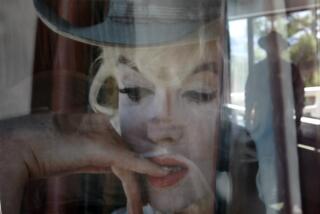The knotty debate over showcasing Pine Knot : Theodore Roosevelt’s retreat may be a natural choice for a tourist spot. But will the changes be unnatural?
- Share via
KEENE, Va. — Here would come the President, striding briskly alongside as his wife and children rode in the horse-drawn carriage, taking a moment now and then to study a distant bird or peer at game tracks beside the dusty road.
The year was 1907, and President Theodore Roosevelt was walking the final leg of the nine-mile trip from the North Garden train depot to Pine Knot, his woodland retreat in the rolling hills three hours south of Washington.
One Roosevelt historian has called Pine Knot the first Camp David, a pastoral place to hide from the pressures and demands of the White House. But while the real Camp David, in the Maryland mountains, is an elaborate compound of buildings, Pine Knot was a simple wood-frame cottage at the edge of a forest.
Roosevelt would go there with only his wife and children, leaving behind the Secret Service, the press and his secretary. The setting was so rustic that even the hardy naturalist John Burroughs complained of the primitive conditions after a visit in which he found a flying squirrel living in the rafters of his room.
But for the carved initials of visiting Boy Scouts, Pine Knot today is much like the cabin the Roosevelts left behind on their last visit 85 years ago, a silent structure nestled among Virginia pines and white oaks, two miles from the nearest paved road.
The tranquillity is about to end, however, because an association is moving toward opening the site to the public. There is talk of a visitors’ center that could accommodate 10,000 to 20,000 sightseers a year, restrooms, nature trails and even a wheelchair ramp so the handicapped can get onto the wooden porch and into the downstairs room.
The trustees of his legacy are divided over whether Pine Knot should be turned into a destination for sightseers. Pine Knot is only 10 miles south of Thomas Jefferson’s Monticello, which attracts more than 500,000 visitors a year.
“This is very perplexing,” said William Harbaugh, a retired University of Virginia history professor and Roosevelt biographer who is heading a group studying the future of Pine Knot. “If we just constructed nature trails, the word would get out and we would have a small percentage of the Monticello crowd. If we built a visitors’ center, it would attract more people and then there would be the problem of security, so we would probably need an apartment for a curator.”
Roosevelt’s grandson, Theodore Roosevelt IV, recently purchased the 90-acre site and donated the property to the Theodore Roosevelt Assn., which restored and preserved Roosevelt’s New York birthplace and Sagamore Hill, the family estate on Long Island. Under the terms of the gift, Pine Knot must be refurbished and opened to the public at least once a year.
Henry Browne, a nationally known restoration architect, has estimated that the two-story cabin can be repaired for about $90,000. The cottage consists of a large open room downstairs with fireplaces at either end and three small bedrooms upstairs.
The cabin, built in 1903, was purchased by Roosevelt’s wife, Edith, in 1905 for $145 in a deal that included 15 surrounding acres. Harbaugh said the family visited about three times a year from 1905 to 1908, during Roosevelt’s second term. Mrs. Roosevelt bought another 75 acres in 1911, when her husband was running for President again, but he lost and they never returned. Mrs. Roosevelt sold the property to a nearby landowner in 1941.
Harbaugh believes that of greater interest than the house, particularly to bird watchers, will be the surrounding forest and fields. During a visit in 1907, Roosevelt and Burroughs recorded sighting 75 species of birds.
Roosevelt is believed to have made the last recorded sighting of the now-extinct passenger pigeon there in 1907.
Only once, for a morning, is Roosevelt known to have worked on affairs of state while at Pine Knot. Rather, he hiked, took long horseback rides with his wife and hunted small game. In an article for Scribner’s Magazine, he recounted a three-day quest for a wild turkey in November of 1906.
The passage tells much about the man, then 48: “Each morning I left the house between three and five o’clock, under a cold, brilliant moon. The frost was heavy; and my horse shuffled over the frozen ruts as I rode after Dick (his companion). I was on the turkey grounds before the faintest streak of dawn had appeared in the East, and I worked as long as daylight lasted. It was interesting and attractive in spite of the cold.”
Harbaugh believes that the greatest value in opening Pine Knot will be to let people see that this was not a President who took his recreation at a country club or seaside resort.
“You think of Harry S. Truman going to Key West or (Dwight D.) Eisenhower at Palm Beach where the golf courses were. Pine Knot makes a statement about . . . the Roosevelts. This is secluded, this is primitive. We’d like to try and preserve that if we can.”
More to Read
Sign up for The Wild
We’ll help you find the best places to hike, bike and run, as well as the perfect silent spots for meditation and yoga.
You may occasionally receive promotional content from the Los Angeles Times.






